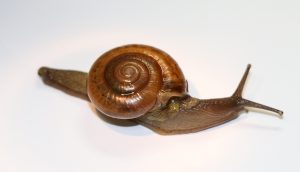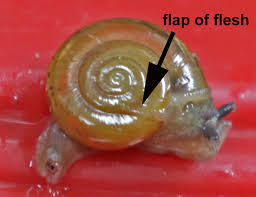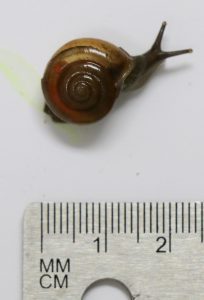At the beginning of August 2020, a new snail was collected in Miami-Dade County. It was identified as the horntail snail, Macrochlamyis indica. It is native from Bangladesh and India. The snail is a high-risk pest because it feeds on a wide variety of plants like liriope, ruellia, plumeria, podocarpus, crotons, cordyline, clusia and like many landsnails, it carries the parasite rat lungworm that is known to cause meningitis in humans.
The identification of the “horntail snail” is easy because of the pointed, fleshy protrusion (caudal horn) at the tip of its tail (Fig. 1) and the flesh that extends around the shell (Fig. 2). The horn-tailed snail has a shell of 16-18.5 mm (0.6-0.7 inches) in diameter (the size of a dime), and it is amber in color (Fig. 3). Like many snails, it is most active at night and after rainfall. When drought or hot weather occurs, the snail will tunnel into the ground to seek cool, damp places. The horntail snail is known to live up to four years and can lay between 45–900 eggs per year, which will begin hatching after 10-17 days. Unfortunately, little information is currently available on the best control methods.



If you see one of these snails, please contact the Florida Department of Agriculture and Consumer Services’ (FDACS) Division of Plant Industry helpline at 1-888-397-1517.
Sources: FDACS/DPI Pest Alert, The Horntail Snail, Macrochlamys indica Benson, detected in South Florida
https://www.fdacs.gov/content/download/93400/file/horntail-snail-pest-alert.pdf
 0
0
